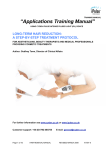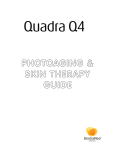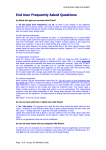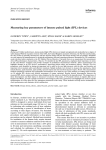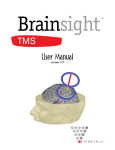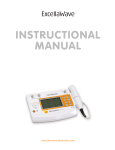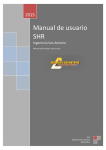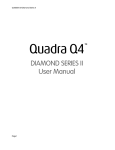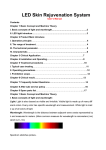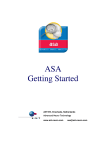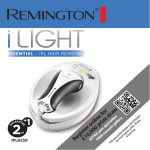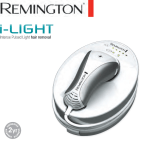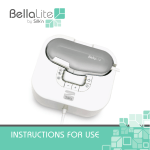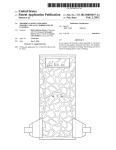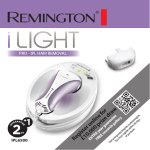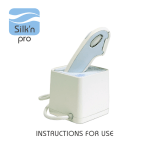Download Untitled - DermaMed Solutions
Transcript
TABLE OF CONTENTS
Indications, Warnings, and Disclaimers ............................................................................2
Introduction .........................................................................................................................3
Long-term Hair Reduction Using Intense Pulsed Light (IPL)...............................................4
Pre-treatment Assessment, Documentation, and Counseling .........................................9
Choosing Treatment Parameters ..................................................................................... 14
Performing Hair Removal with the Quadra Q4® ........................................................... 20
Practical Tips by Body Area ............................................................................................. 25
Handling Treatment-related Problems ............................................................................ 41
Post-treatment Care and Counseling ............................................................................. 43
References/Bibliography ................................................................................................. 44
1
Indications, Warnings, and Disclaimers Page
USA FDA 510K CLEARANCE K071883
Quadra Q4® intense pulsed light is indicated for use in Dermatological and Plastic
Surgery applications and specifically for long term stable, or permanent, hair
reduction. In addition, Quadra Q4® is indicated for the treatment of benign
cutaneous vascular lesions and the treatment of benign pigmented lesions.
Quadra Q4® is indicated for the treatment of mild to moderate inflammatory Acne
Vulgaris.
WARNING
The information provided in this document is intended for general guidance in the
use of the Quadra Q4® IPL device for long-term hair reduction. It is not intended as
an expert protocol or medical advice. The treatment parameters suggested here
are those reported by experienced users in published literature or reported directly
to DermaMed Solutions, LLC. However, the user alone bears full responsibility for
choosing treatment parameters, operation of the device, and appropriate patient
care.
TRAINING
Training is a key factor in consistently achieving successful treatment outcomes. At
a minimum, all operators should receive basic training in light science, light-based
hair removal, and the safe use of laser/IPL devices. No two devices are identical in
the way they deliver light energy, so it is vital to obtain training. Contact DermaMed
Solutions, LLC for training opportunities.
2
INTRODUCTION
Lasers and intense pulsed light (IPL) devices have been used in aesthetic applications now
for more than ten years. In that time, both the technology and treatment practices have
improved. Today, people with almost all skin types can take advantage of light-based
treatments for long-term hair reduction.
Lasers and IPL devices target melanin in hair follicles. Light absorbed by melanin is
converted into heat that in destroys the cells responsible for hair regrowth.
Very dark skin types may not be appropriate for light-based treatment because high levels
of melanin in the epidermis absorb light energy and increase the risk of epidermal
damage. Red-head, blonde, and grey/white hair types respond poorly to light-based
treatments because their follicles lack sufficient melanin to absorb the energy.
It’s important that patients have realistic expectations about the permanence of hair
removal. Although light-based treatments will permanently reduce the total number of
body hairs, and although the hairs that re-grow will often be finer and lighter in color,
treatment will not result in a permanent removal of all hair in the area treated. More
precisely, light-based hair removal will result in long-term, stable reduction in the number
of hairs re-growing after a treatment regimen, which may include several sessions.
3
LONG-TERM HAIR REDUCTION USING INTENSE PULSED LIGHT (IPL)
How It Works
The skin has three primary targets that absorb light: melanin, blood, and water. These
targets are called chromophores. Light energy absorbed by chromophores is converted to
heat energy.
Hair removal using Quadra Q4® light therapy consists of creating sufficient heat in the hair
follicle to damage the cells that cause hair re-growth. During treatment, light that isn’t
reflected off the surface scatters in the skin where it is absorbed by melanin in the hair
follicle.
The light energy is converted to heat energy, and by conduction, the heat is transferred to
adjacent cells. Sufficient heating kills the cells and prevents the follicle from growing new
hair.
Light-based hair removal. Light that isn’t reflected from the surface (a) is scattered
in the skin (b) and is absorbed by melanin in the hair follicle (c). Sufficient heating
destroys surrounding cells and prevents growth of new hair.
Protecting the Epidermis
Because the epidermis also contains melanin (which gives skin it natural color), care must
be taken to select appropriate energy levels that effectively remove hair without damaging
the surrounding epidermis. Similarly, suntan and fake tan absorb light energy like naturally
dark skin, and light-based hair removal treatments should be delayed until all active tan
and fake tan has subsided.
4
Characteristics of Light that Affect Absorption
As you might expect, the amount of radiant energy that will be absorbed by a tissue also
depends on characteristics of the light source, specifically energy level applied, the
wavelengths of the light, the spot size of the delivery device, and the duration of each pulse
of light.
Wavelength. The wavelength of the light energy is a key parameter that affects the
interaction between a light and the tissue. IPL devices produce mostly visible broad-band
wavelengths of light. Potentially harmful, short wave UV light (<400 nm) is filtered out by
the lamp itself. and hardly any long-wave infrared light is produced by a xenon lamp. The
remaining wavelengths between 530 nm and 1000 nm are well absorbed by melanin.
IPL wavelengths and absorption. The spectral distribution of a typical xenon lamp
IPL overlaid with absorption curves for blood (red), melanin (black), and water
(blue).
Spot size. The spot size of the light source’s delivery device can also affect the depth of
penetration of the energy. In a highly scattering medium such as skin, light diffusion at the
edges of the beam causes spreading of the energy as it penetrates into the tissue. As a
consequence, a larger spot size delivers more energy at a given depth.
Unlike traditional IPL devices, the Quadra Q4® uses twin flash lamps to produce a large
rectangular spot size on skin of 8.9 cm2, which ensures that the light energy penetrates
deeper into the skin. With the Quadra Q4®, there is no need to overlap spots and the large
spot size ensures faster and more comfortable treatment.
5
Depth of penetration by spot size. Large spot sizes increase depth of
penetration.
Pulse duration. The total amount of energy applied to a tissue in a single pulse is
determined by the energy level (or fluence) and the duration of the pulse.
The pulse duration is not only important in determining energy applied; it is also important
in the selective destruction of target tissues. Generally, the pulse of IPL light used will be
longer for thicker hair and shorter for finer hair.
By choosing long pulses of light for hair removal, the operator will avoid collateral damage
to epidermal melanin as the tiny particles of melanin in the skin have time to lose absorbed
heat during a long pulse (compared with, say, a much larger hair follicle structure which
will hold its heat longer).
6
The Hair Growth Cycle and Repeated Treatments
Hair grows in a cycle of three phases. The anagen phase is the growth phase of the hair.
The catagen phase is a brief portion of the hair growth cycle in which the growth stops.
The telogen phase is the dormant phase of the hair. Hair can only be treated successfully
during the anagen phase because it is the only phase in which the follicle contains
sufficient melanin for effective heating.
Anagen
Catagen
Telogen
Hair growth cycles. Hair can only be treated successfully during the anagen
phase.
Each follicle in human skin maintains an independent growth rhythm from the other
follicles. At any given time, the majority of hair follicles are at some point in anagen. The
remaining follicles are either in catagen or telogen.
Because hair can be removed effectively by light-based methods only during anagen,
several treatments at different times are required to destroy all of the hair follicles in an
area for long-term or permanent hair reduction.
7
Treatment effect by stage of hair growth. In this cross-section, only two hairs are
in anagen before treatment. Treatment destroys the two hair follicles, but does not
affect the remaining hairs that are in either catagen or telogen.
An average of 6-10 sessions is needed for permanent hair reduction (depending on the
hair color, thickness, density, etc.), and 4-10 weeks is the recommended gap between
sessions depending on the new growth cycle and the body area.
Long-term or Permanent Hair Reduction
Remember, even repeated treatment will not result in a permanent removal of all hair in
the area treated. More precisely, light-based hair removal will result in long-term, stable
reduction in the number of hairs re-growing after the treatment regimen. The process is
thought to work as follows:
•
Hair growth is delayed as the hair growth cycle is ‘accelerated’ into the telogen
phase which on some parts of the body may be several months.
•
Hair follicles damaged by exposure to intense flash of light are ‘miniaturized’ and
re-grow as lighter-colored, finer hairs or vellus hair (no color).
•
Hair follicles are completely coagulated resulting in permanent damage to the cells
responsible for their re-growth.
8
PRE-TREATMENT ASSESSMENT, DOCUMENTATION, AND COUNSELING
Patients considering any IPL indication should go through a pre-treatment assessment and
documentation process. The process includes:
•
Providing detailed information about the procedure and its risks
•
Taking a medical history to elicit any special circumstances, photo-sensitizing
medication or potential contraindications
•
Determining the patient’s skin type
•
Answering any questions the patient may have
•
Helping set realistic patient expectations about the outcome of the treatment
•
Obtaining informed consent and reviewing with the patient
•
Performing a test treatment (for suitable patients) to establish predicted treatment
parameters
•
Carefully recording all relevant information gathered
•
Setting a follow-up appointment to evaluate the test and begin treatment
•
Sending the patient home with instructions for pre-treatment skin care
Skin Analysis – Fitzpatrick Skin Typing
Skin type is one of the most important factors in identifying whether patients are
appropriate candidates for light-based hair removal and in determining initial treatment
parameters.
Skin is most often classified based on the Fitzpatrick Skin Classification Scale. The scale
classifies skin based on complexion (pigmentation) and tendency to burn. According to
Fitzpatrick, skin can be classified according to six types, as shown in the table and figure.
9
Fitzpatrick Skin Classification Scale
Skin Type
1
2
3
4
5
6
Skin Color
•
Caucasian
•
Very light complexion
•
Light eyes
•
Freckles
•
Usually blond or reddish hair color
•
Caucasian
•
Light complexion
•
Light eyes
•
Occasional to frequent freckles
•
Blond, reddish, light brown hair color
•
Darker Caucasian; light Asian
•
Medium complexion
•
Light to dark eyes
•
Hair color usually brown to dark
•
Mediterranean; Asian; Hispanic
•
Darker complexion
•
Dark eyes
•
Dark brown to black hair color
•
Middle Eastern; Latin American; lightskinned black; Indian
•
Dark complexion
•
Dark eyes
•
Dark brown to black hair color
•
Dark-skinned black
•
Black complexion
•
Black eyes
•
Black hair color
Characteristics
Always burns;
never tans
Usually burns;
tans with difficulty
Sometimes mild
burn; gradually
tans
Rarely burns; tans
with ease
Very rarely burns;
tans very easily
Never burns; tans
very easily
Visual representation of the Fitzpatrick Skin Classification Scale
10
Contraindications
Patients with any of the following contraindications should not be treated with IPL unless a
letter from the patient’s primary care physician is available confirming that the patient can
be treated safely.
•
Tanned skin (active tan) through sun exposure or tanning bed use in the previous 30
days (because of increased risk of hyper pigmentation)
•
Waxing, plucking, ‘sugaring’ or ‘threading’ depilation treatment of the area in the
previous 4-6 weeks (because the follicle has been removed)
•
Hypopigmentation (e.g. vitiligo)
•
Any inflammatory skin condition (e.g. eczema, active Herpes Simplex, etc. at the
treatment site because it may aggravate the condition)
•
Presence or cancer or current cancer drug therapy
•
History of keloid scarring (because any IPL burn may produce a keloid scar)
•
Epilepsy (because repeated consecutive flashes may induce a fit)
•
Use of St. John’s Wort (herbal remedy) in the past 3 months for depression (due to
photosensitivity)
•
Use of oral isotretinoin or tretinoin in the previous 3-6 months for the treatment of acne
or other dermatological conditions
•
Pregnancy; until periods return and breastfeeding is stopped (because hormonal
imbalance may reduce treatment effectiveness)
•
Use of drugs for diabetes (due to possible photosensitivity and poor wound healing)
•
Use of anti-coagulant drugs
•
Presence of a pacemaker unless the pacemaker manufacturer confirms in writing that
it is safe to treat the patient
•
Use of any topical medication, perfumes, deodorants, sun block, essential oils, or other
skin lotions (which could cause photosensitivity)
•
Presence of surgical metal pins or plates under the tissue to be treated
•
Age under 18 years if the establishment is not registered to treat children or if parental
permission is withheld
11
A doctor’s letter should also be obtained before treating patients who are reportedly using
quinidine, any anti-psychotic medication or large combinations of cardiac/diuretic drugs,
topical steroid creams in the area to be treated, general anesthesia in the last 3 months,
local anesthetic treated areas in the past month, and any cases in which you are uncertain
about any reported medical condition or medication.
Treat with caution and obtain a doctor’s letter if you are uncertain about anyone who has:
•
Fake tan
•
Allergies
•
Hormone abnormalities such as polycystic ovarian syndrome
•
Cold sores in the treatment area
•
Previous depilation treatments
•
Reported HIV infection or hepatitis
Transsexuals may be treated although results can vary and Quadra Q4® treatment should
follow 6 months after completion of hormone therapy.
Conditions that affect hormone levels such as thyroid conditions, oral steroids, hormonal
therapy, and polycystic ovaries can be treated but results may vary and patients should be
made aware of reduced or delayed realistic outcomes.
Pre-treatment Counseling
Patients should be instructed in pre-treatment skin care and should be provided with takehome instructions recommending that they:
•
Don’t expose their skin to UV light (sun exposure or the use of tanning beds) or self tan
for at least 4 weeks before and/or between IPL treatments.
•
Don’t depilate with waxing, plucking, or threading (shaving or depilatory creams are
acceptable) before and/or between IPL treatments.
•
Don’t use bleaching creams, or perfumed products (e.g. aromatherapy oils) for 24-48
hrs before treatment sessions.
•
Avoid swimming in strong chlorinated water immediately before an IPL treatment
session.
•
Avoid exfoliating, microdermabrasion, or peels for 1 week before treatment sessions.
•
Keep the area to be treated clean and dry.
12
•
Hydrate the body by drinking plenty of water.
•
Protect the skin from sun exposure with suitable clothing and use of sunscreen of SPF
30+ before first treatment and between subsequent treatment sessions.
Patients should be advised that for the treatment session they should:
•
Avoid wearing tight clothing.
•
Do NOT use sun-blocking creams within 24 hrs of scheduled treatments.
13
CHOOSING TREATMENT PARAMETERS
IPL systems work by heating target tissues sufficiently to damage or destroy them. In hair
removal, the overall objective is to find the optimal therapeutic window where the energy
absorbed is sufficient to damage the follicle without causing significant damage to
surrounding epidermal tissue.
Treatment Parameters
Quadra Q4® systems have two primary parameters operators can adjust to determine the
therapeutic window:
•
Fluence is a measurement of energy density; in other words, it is the amount of energy
delivered (in Joules) per square centimeter. Higher fluence means more energy
delivered to the tissue.
•
Pulse duration, as discussed previously, is the length of time over which the pulse of
energy is delivered. Pulse duration is usually measured in milliseconds (msec). At a
given fluence, long pulse durations deliver energy more slowly; short pulse durations
deliver energy more quickly.
The appropriate fluence and pulse duration depend on the patient’s skin type (Fitzpatrick
Scale) and the condition being treated. In general, darker skin should be treated with
longer pulse durations.
14
Treatment Programs
The treatment programs available for hair removal are shown in the figure. The range of
available pulse lengths and energy levels is similar to that available in the Professional
version; how they’re chosen is the primary difference.
Treatment Parameters Are Guidelines Only
The parameters listed in this table and throughout this treatment guide are intended as guidelines
only. The use of test patches is strongly advised as patient-to-patient variation may affect the
treatment outcome and the possible incidence of side effects.
How to Choose Treatment Parameters – General Guidelines
To choose the initial treatment parameters:
•
Exclude all unsuitable subjects (eg, those with pre-existing medical conditions such as
cancer, those taking contraindicated drugs, those with suntans, etc.)
•
Determine the subject’s underlying Fitzpatrick Skin Type AND the skin type of the area
to be treated. A subject’s general Fitzpatrick Skin Type is assessed on a body area not
normally exposed to the sun. The area to be treated may appear different from the
underlying skin type due to sun damage, age, or specific local skin tone that must be
taken into account.
15
•
Use the list of treatment program options in the User Manual for the system being
used or in the appropriate treatment guide (ie, Hair Removal or Photoaging) to identify
starting programs.
•
Undertake test areas at several increasing energy density levels until a suitable starting
energy level is determined.
•
The starting energy is that which will produce a heat response in the skin, which feels
hot or like a prickle to the patient but is tolerable. In addition, some redness may
develop in the treatment area within a few minutes. Should a strong histamine-like
(allergic) reaction occur with swelling immediately around the hair follicles with general
“raw’ redness around the area, the energy level is too high.
•
Normally, the skin will feel warm temporarily after treatment, and any redness will
disappear within minutes or a few hours.
Typical Treatment Parameters for Hair Removal
For lighter skin
Clinical data have shown that for lighter skin types (Fitzpatrick Skin Types 1-3) single pulses
of 25-40 msec with energy ranges of 12-16 J/cm2 have proven to be effective.
The choice of treatment program also depends on the hair thickness.
Hair Removal Treatment Parameters for Light Skin
Fitzpatrick Skin
Type
Hair Thickness
Joules/cm2
1
Thin
12-16
1
Medium
12-16
1
Thick
12-16
2
Thin
12-16
2
Medium
12-16
2
Thick
12-16
3
Thin
12-16
3
Medium
12-16
3
Thick
12-16
16
For dark skin
Darker skin can react to light treatment by hyper- or hypo-pigmenting so it is best treated
with a longer pulse width to spread out the energy and make the treatment safer and
more comfortable. This means either using a higher number program in the single shot
section or using multi-pulsing.
As the skin color darkens, the energy range should stay in the same region; however, triple
pulses should be used to allow inter-pulse epidermal cooling.
Hair Removal Treatment Parameters for Dark Skin
Fitzpatrick Skin
Type
Hair Thickness
Joules/cm2
4
Thin
10-14
4
Medium
10-14
4
Thick
10-14
17
TEST TREATMENTS
Testing is required to establish the best starting IPL energy level and to reduce the risk of
unwanted side effects from over-treatment.
Test areas should be evaluated on or near the treatment site using the lowest
recommended fluence for the skin type, increasing the fluence if necessary until the patient
feels a ‘ping’, heat, or mild discomfort (according to the individual’s pain tolerance). Testing
should be ceased immediately if any side effects occur.
When performing the first test area on a new patient you have only 1-3 chances to
establish the energy level. For larger areas such as facial areas, décolleté, forearms, etc, it
is easy to establish a test area. However, for small areas such as specific pigmented
blemishes, spider nevi, etc, only one shot can be made. In that case, it should be the best
estimated shot.
On Lighter Skin (Types 1-3), use this sequence:
•
One shot at the lowest energy level predicted by skin type
•
One shot 1 J/cm2 above the lowest predicted energy level
•
One shot 2 J/cm2 higher than the lowest predicted energy level to evaluate tissue
response
On Darker Skin (Type 4), use this sequence:
•
One shot 0.5 J/cm2 below the lowest energy level predicted by skin type
•
One shot at the lowest energy level predicted by skin type
•
One shot 0.5 J/cm2 above than the lowest predicted energy level to evaluate tissue
response
The choice to go higher with the second and third test shots will be based upon a number
of factors including:
•
Did the patient experience the sensation of a ‘ping’ or heat?
•
Is the area in question tanned?
•
What has been the patient’s response to treatment on other body areas (for patients
who have been treated previously)?
18
Post-testing Instructions
After testing, patients should be given clear instructions on post- Quadra Q4® skin care, in
particular sun avoidance and avoidance of injury to the skin.
Recording
Details of the test treatment performed should be recorded in the patient’s record,
including:
•
Treatment area
•
Quadra Q4® type
•
Program
•
Pulse width
•
Fluence
•
Number of shots
The entry should be signed, timed, and dated. The Quadra Q4® treatment register (log
book) must be completed recording treatment in the same way.
Follow-up
Patients with skin types 1-3 should return in 3-7 days for final evaluation and treatment.
Patients with skin types 4-5 should wait for 14 days to be sure no late emerging side effects
occur.
19
PERFORMING HAIR REMOVAL WITH THE QUADRA Q4®
Treatment Room Set-up Check List
•
Make sure any required IPL hazard warning notices are in place at entrances.
•
Close window blinds and cover any mirror surfaces to reduce reflection hazard.
•
Check fire extinguisher location (suitable for electrical fires).
•
Make sure all Local Rules, Treatment Protocols, and patient documentation is available
for reference.
•
Check availability of all required supplies: couch roll, razors, gloves, tissues,
refrigerated clear ultrasound gel, wooden spatulas, skin cooling gel packs, white
marker pencils, wipes, post-treatment skin calming lotion (such as dmSkincare’s derma
renewal gel), etc.
•
Close the entrance door to prevent unauthorized entry and to protect the privacy and
dignity of the patient by suitable means e.g. use towels during intimate area treatment,
eye safety, etc.
•
Check ventilation (extractor fan, air conditioning, etc).
[Contact your Laser Protection Advisor for further assistance on safety issues.]
20
Patient Preparation Check List
•
Ensure all patient questionnaires (general medical history) and consent forms are
completed and signed by the patient and the operator. Consent Forms should ideally
be signed each time before an IPL treatment.
•
Ask patient to remove all jewelry, make up, deodorant, etc in the treatment area.
•
The treatment area (or test area) should be shaved before treatment. The patient
should attend with unwanted hair present (at least stubble a few mm long) so that the
operator can check hair thickness and color at the treatment site accurately.
Hair removal treatment sequence
•
Remove any loose hairs (from shaving) using gauze or adhesive tape (as hair left on
the skin surface will absorb Quadra Q4® IPL energy first).
•
The area should be cleaned with water only; any creams may leave a residue, which
could affect the efficiency of the treatment.
•
Mark the extent of the skin area to be treated with a white eye liner pencil.
•
In the area to be treated, ‘white-out’ small lesions, moles, etc. and cover any sensitive
areas (tattoos, lips, etc) with cut-out adhesive white labels to protect them from
absorbing light energy.
Cover sensitive areas
21
•
Give the patient and any assistant or observer present in the room suitable protective
safety glasses.
•
Disposable adhesive ocular shields should be placed over the eyes of the patient if
treating facial areas near to the eyes where safety glasses would allow light
penetration under the rim. Ocular shields are available for purchase through
DermaMed Solutions Item #31-9300 IPL Eye Shields - $75.00 for a 50 pack.
•
Set up the Quadra Q4® program and predicted energy setting (based on skin type, hair
density, etc).
•
Cool the area with ice (recommended) or if you will be using a cold pack change
frequently to ensure temperature is effective enough to cool the skin.
Cold packs – change frequently during treatment
•
The operator must wear suitable safety glasses during Quadra Q4® treatment and
“blink” during the flash to limit light entering the operator’s eyes and thereby improve
visibility of the treatment area after the flash.
If Using Gel
•
If you choose to use clear ultrasonic gel, either dispense sufficient ultrasound gel
into a small container or deposit ‘blobs’ of clear ultrasound gel directly onto the
skin from the dispenser bottle and using a clean wooden spatula, spread a layer
of gel over the skin approximately 2 – 3 mm thick. The gel must be kept cold (but
not frozen) in a fridge.
•
Do not ‘overwork’ the gel on the skin, as it will heat up. Do not reuse the gel
(infection risk).
22
Using the Quadra Q4® Applicator
•
Place the light guide (crystal) flat to the skin touching the surface of the skin.
•
Press the light guide into the area being treated.
•
Use firm pressure when treating hair with the contact crystal to bring the hair shaft
closer to the light source and improve absorption in the hair.
The light guide should be flat against the skin
•
Place the treatment spots directly next to one another with minimal overlap.
•
Make sure there are no gaps between the treatment spots.
Beware If:
•
The light guide overlaps a previous treated area (over-treatment risk).
•
The light guide treats skin without hair (no effect), over tattoos or tanned skin (overtreatment risk).
•
The light guide leans to one side (insufficient energy delivered to the target).
•
Part of the light guide is not in contact with the skin (insufficient energy delivered to the
target).
After Using the Quadra Q4® Applicator
•
Ensure that the skin area is completely treated (no obvious gaps).
•
Put the Quadra Q4® into STANDBY.
•
Remove safety eyewear.
•
If using gel, once the area has been treated, remove the ultrasound gel using a
spatula and then tissues.
23
•
Check the area for redness and record in patient notes.
•
Apply ice or a cooling gel pack to any sensitive areas if required.
•
Apply a calming lotion such as dmSkincare’s derma renewal gel or D20 solution.
•
Always use a sunscreen of SPF 30 or higher. We recommend dmSkincare’s daily
eclipse SPF 30 physical sunscreen.
•
Complete the patient treatment notes and record any unusual occurrence.
•
Provide post-treatment advice and take-home information sheet (found at the end of
the manual).
•
Book your patient’s next treatment.
•
Switch-off the Quadra Q4®, clean the crystal treatment guide with a moist tissue or an
isopropyl wipe and prepare the room for the next patient.
24
PRACTICAL TIPS BY BODY AREA
All areas of the body can be treated except inside the orbit of the eye (eg, underneath the
eyebrows) or on mucous membranes (eg, inside nostrils, ears, etc.).
Facial Area
Make a line of treatment spots down the face along the jaw line and add rows above as
necessary where hair removal is needed until all required cheek areas are covered.
Pay particular attention to the following points:
•
Avoid accidentally treating the scalp hair.
•
Do not promise long-term hair reduction on vellus or accelerated (long) vellus hair.
•
Remember the hair growth you see may be hormonal and can take many sessions to
control.
•
Use a piece of white ‘Fibrella’ cloth, white card or white adhesive label to shield areas if
required.
Gap between treatments: 4 weeks. Number of sessions: typically 8-10.
25
Upper lip
When treating hair on the upper lip (moustache area), remember that the central area
below the nostrils (nasal alia) is particularly sensitive. Mostly the upper lip area can be
treated with 2-3 shots (depending on spot size) but an extra shot may be needed at each
corner of the mouth (just above and lateral to the lip commissure) where additional hair
growth is often found.
•
Remember to remove all lip gloss, lip salve, or make up.
•
Apply white pencil to mask any semi permanent lip liner on the lip margin.
•
Shield the lips with damp cotton wool or white adhesive label before treating.
•
Use gel sparingly as it can easily obstruct the nostrils, which is unpleasant for the
patient.
Gap between treatments: 4 weeks. Number of sessions: from 10 sessions.
26
Chin area
Hair growth under the chin (sub mental area) can be dense and coarse and care should
be taken with fluence settings.
•
Reduce fluence over the bone.
•
Perform test areas under the chin if possible.
•
Change positioning depending on the shape of the chin.
•
Press light guide firmly to bring the light energy closer to deep follicles.
•
Avoid over-treating the lower third of the neck, which does not heal easily.
Gap between treatments: 4 weeks. Number of sessions: typically 8-10.
27
Male beards
Most typically, men request beard re-shaping to reduce hair growth on the lower third of
the neck where shirt collars rub and leads to soreness following shaving and in-growing
hairs and inflamed/infected hair follicles (pseudo-folliculitis barbae—PFB). Care should be
taken on the lower third of the neck because this area is delicate and does not heal as well
as facial areas if over-treated. Also, first treatments of the beard in this area should be
cautious as there may be a lot of hair, which means a lot of melanin and consequently a
lot of heat / discomfort generated in the IPL treatment. It is one of the areas where the use
of reusable cooling gel packs (kept in the freezer) can be helpful both for about a minute or
two before treatment (to reduce level of discomfort) and afterwards to draw out heat from
the area and reduce inflammation. Post treatment application of derma renewal gel or
other calming lotion is desirable. Results of treatment can be excellent in this area and
much appreciated by the patient.
"Spot" clearing of hair on the upper cheeks can also be undertaken but full clearance of the
beard is not advisable except in gender reassignment cases ("he to she") since complete
removal of the beard changes facial masculinity characteristics and makes the face look
more feminine. Complete loss of male facial hair can also result in certain premature
ageing characteristics emerging (as occurs in women) such as upper lip "whistle lines".
White hair in older males usually needs some additional electrolysis treatment to remove
these resistant hairs completely.
Gap between treatments: 4 weeks. Number of sessions: typically 8-10 (full beard removal
will 15+ sessions).
28
Hairline
The hairline has a high percentage of anagen hairs and therefore may be treated every 4
weeks or less. Remember to cover the rest of the hair with a white headband or towel to
protect follicles along the hairline.
•
Use a mirror with your patient before treatment so you can discuss areas precisely.
•
Remember to reduce the fluence over the bone.
•
Try not to overlap pulses.
Gap between treatments: 4 weeks. Number of sessions: typically from 8 sessions.
29
Middlebrow
The hair between the eyebrows should be treated with caution. Particular care should be
taken at the edge of eyebrows where angled growth of hair follicles may lead to unwanted
reduction. Where space is insufficient for the size of the crystal block, it may be necessary
to shield the rest of the eyebrows with white self-adhesive labels.
•
Place opaque eye-shields or cotton wool pads over the eyes.
•
Apply sufficient cooling gel.
•
Use a single shot only.
•
Avoid treating eyebrows for ‘shaping’ reasons as the hairline may appear permanently
notched or broken following treatment as precise hair follicle position in the eyebrows
is difficult to determine.
Gap between treatments: 4 weeks. Number of sessions: typically 8-10.
30
Bust and décolleté
Unwanted hair growth in female patients can occur in the center of the chest (between the
breasts) and this can be treated easily taking care with energy settings as the chest bone
(sternum) is close to the body surface in this area and may be sensitive. Moreover, the
décolleté is often tanned and sun-damaged and does not heal easily if over-treated,
therefore, treat with caution, starting with lower fluence levels.
More commonly, unwanted hair appears around the periphery of the areola, which may
be treated as follows:
•
Cover up the red (areola) nipple area using shields, ‘Fibrella’ cut-outs, white adhesive
labels or damp cotton gauze.
•
Do not treat over the darker areola skin as more energy will be absorbed here.
•
With the nipple safely protected, the whole area may be treated in rows (over the
protective shielding) to ensure that all the hairs at the margin of the areola are treated.
Gap between treatments: 4 weeks. Number of sessions: typically 8-10.
31
Male chest
Unwanted chest hair growth in male patients can be treated easily taking care with energy
settings as the chest bone (sternum) is close to the body surface in this area and may be
sensitive.
•
Mark gridlines to delineate sub-divided areas of treatable size using a white pencil.
•
Reduce the fluence over bone or dense hair; use cooling packs.
Gap between treatments: 4 weeks. Number of sessions: typically 8-10.
Abdomen
Unwanted body hair often appears on the lower abdomen, usually concentrated along a
line from the navel to the pubis.
•
Do not treat over any jewelry (to avoid focusing energy inadvertently).
•
Treat in rows from the navel to the top of the bikini line (pubis)
Gap between treatments: 4 weeks. Number of sessions: typically 8-10.
32
Backs
Male and female backs should be marked with gridlines using a white pencil. Only work in
“zones” to avoid gel warming too much in areas waiting to be treated. Take care when
treating over bony areas (spine and scapula).
Gap between treatments: 4 weeks. Number of sessions: typically from 10 sessions.
33
Arms
•
Mark out the sub-divided area to be treated using a white pencil.
•
It is preferable to treat around sections of the arm rather than along the length of the
arm. If required you can treat around the elbow or wrist.
Gap between treatments: 4 weeks. Number of sessions: typically from 8 sessions.
34
Half legs
It is usually easier to treat around the leg than along the length of the leg.
•
Section off the leg in rectangular gridlines using a white pencil.
•
On the shin and ankle, reduce the fluence because of sensitivity caused by proximity to
bony areas. Treatment here can be painful, especially the ankle.
•
Remember the patient will have to move several times to allow the operator access to
all aspects of the legs.
Gap between treatments: 6 weeks. Number of sessions: typically from 8 sessions.
35
Knees
•
Treat the knee with the leg out straight, not bent.
•
Adapt the light guide to the shape of the knee.
•
If the knee is bony, treat at lower fluence, similar to the setting for shin and ankle.
Gap between treatments: 6 weeks. Number of sessions: typically from 8 sessions.
Upper legs
•
Mark out the legs in sections with gridlines using a white pencil.
•
Treating large areas like the upper leg or thigh can be stressful and tiring for the
patient.
•
Cool the areas in sections and change the cooling gel periodically. (approximately
every 30 flashes) to avoid excessive heat build-up.
Gap between treatments: 6 weeks. Number of sessions: typically from 8 sessions.
36
Toes and fingers
Every patient is a different shape; adjust the position of the light guide to suite the shape of
the patient’s treatment area. It is possible to treat two adjacent digits with a single flash.
Gap between treatments: 4 weeks. Number of sessions: typically from 8 sessions.
37
Underarms
The underarms are probably the easiest area to start with and to learn Quadra Q4® use.
However, some parts of the underarm can be very sensitive (especially in the centre where
hair growth is thickest) so start at the farthest hairs out on the arm (towards the elbow) and
move steadily towards the breast telling the patient it will get more sensitive towards the
middle of the treatment. A single row of 4-5 shots is usually sufficient on most patients.
Gap between treatments: 4 weeks. Number of sessions: typically 6-8 sessions.
38
Bikini line
There are three different types: “Bikini”, “Extended” and “G-String”. The simplest is the Bikini,
which follows the line of the underwear (beware—only treat with white lingerie), which is
usually described as the “upper groin” area. The “Extended” bikini line refers either to the
inner groin area or front of thighs. “G-String” describes an area including the natal cleft
(area around but not including the anus).
Only experienced therapists should attempt these treatments with IPL.
•
Patients should be provided with disposable, white cotton g-strings. On no account
treat over dark colored underwear as it will absorb IPL energy.
•
Start from the least sensitive and lightest area of the groin at an appropriate fluence for
the skin color (see Treatment Parameters). It is recommended to treat both upper groin
areas before moving on to the next area as the machine settings will usually be
similar.
•
When treating the Extended bikini line, it will normally be necessary to adjust the
parameters to accommodate the darker pigment in this area. Again treat both areas at
the same time. Finally, for the G-String, particular care should be taken to further
reduce fluence where necessary and avoid treating the mucous membrane of the anal
area directly.
•
In males, treating the penis should be avoided.
Gap between treatments: 4 weeks. Number of sessions: typically from 8 sessions.
39
Intimate body areas—treatment procedures
If you are requested to do treatments on patients wishing to have intimate areas treated,
male or female, these are the following procedures you should consider:
•
If you not wish to do this treatment, don’t.
•
Another member of staff may be present for additional personal security.
•
Always respect the privacy and dignity of the patient.
•
More cooling gel than normal should be applied to delicate areas.
•
Cooling should be extended for delicate areas.
40
HANDLING TREATMENT-RELATED PROBLEMS
After treatment, the skin may be red and feel warm. These normal transient changes
should disappear within minutes or a few hours – 24 hours at the most. More severe
treatment-related side effects may also occur with overtreatment. They may appear
immediately or shortly post treatment (0 – 24 hrs); in rare cases, late emerging side effects
(typically 24 – 72 hrs) may occur.
Management of Treatment-related Side Effects
Timing
Immediate
Post Treatment
Side Effect
Excessive pain
Excessive persistent heat and
redness
Damage to natural skin texture
(crust, blister, burn)
Edema, fragile skin, purpura
Late Emerging
Change in pigmentation
(hyper- and hypopigmentation)
Excessive hypo-pigmentation or
scarring
Prolonged itching in the
treatment area
Ineffective skin therapy
Management
•
Stop treatment
•
Cool the skin and moisturize
•
Review after 24 hr and restart treatments at lower
fluence
•
Normally resolves in 24 hrs
•
If a burn-associated reaction is expected, a one-time
application of a local steroid ointment may be
indicated (medical prescription)
•
Cool the area regularly using cloth-wrapped ice
packs or cooling gel
•
Advise the patient to use pure aloe vera and skin
protection as for a mild sunburn until the sensation
disappears
•
If the reaction persists, have the patient consult a
doctor
•
Cool area thoroughly for pain relief
•
If already blistered or burn, recommend burn sprays
and creams from the pharmacy
•
Have the patient consult a doctor
•
Follow the adverse incident procedure
•
Cool area throughout for pain relief
•
Have the patient consult a doctor
•
Follow the adverse incident procedure
•
Advise the patient to moisturize and protect the skin
from sun exposure and further injury
•
Instruct the patient to leave the skin alone and not to
rub it
•
Have the patient consult a doctor if the condition
persists
•
Advise the patient to avoid skin exposure and use a
sun block for six months
•
Have the patient consult a doctor
•
Follow the adverse incident procedure
•
Advise the patient to keep the area cool and to apply
pure aloe vera gel
•
Have the patient consult a doctor if the itching
persists
•
Reassess the patient’s history and increase fluence
depending on skin reaction
41
Only retreat areas that have experienced treatment-related side effects when the areas
have healed fully and only after testing is repeated.
Adverse Incident Procedure
If anything goes wrong during treatment, such as serious skin reaction, excessive pain,
patient taken ill, etc., treatment should be stopped immediately. Appropriate information
should be recorded in the patient notes, including the extent of the partially completed
treatment and details of any untoward side effects.
Serious skin damage should be referred immediately to the Emergency Department of the
nearest hospital or via the patient’s doctor to an appropriate medical specialist if
necessary.
In all cases of eye damage or suspected eye over-exposure to the Quadra Q4® flash, an
immediate eye test by an ophthalmic specialist should be arranged through a doctor or the
Emergency Department of the nearest hospital.
Adverse Event Reporting
Adverse event reporting requirements vary by state. Serious adverse events are those
involving death, life-threatening injury, hospitalization, disability, or congenital abnormality
as well as those that require intervention to prevent permanent impairment or damage. In
general, serious adverse events must be reported to regulatory authorities in a timely
manner.
Procedure in the Event of Equipment Failure
In the event of equipment failure, treatment should be abandoned immediately and the
emergency stop button pressed and/or the key removed to prevent any risk of further
emission of Quadra Q4® energy. Remove the mains plug.
Appropriate details should be recorded in the patient notes, including the extent of the
partially completed treatment and details of any untoward side effects.
The Quadra Q4® factory service engineer should be informed immediately of the
circumstances of the equipment failure and an Incident Report completed.
42
POST-IPL TREATMENT INSTRUCTIONS
Patients should be instructed in post-treatment skin care and should be provided with
written take-home instructions recommending they:
•
Don’t expose skin to UV light (sun exposure or the use of tanning beds) or self tan for at
least 2 weeks.
•
Don’t shave for 48-72 hrs after facial treatment.
•
Don’t use bleaching creams, or perfumed products for 24-48 hrs.
•
Don’t pick or scratch the treated area.
•
Avoid rough handling of the area treated.
•
Leave any skin responses alone (they are temporary and will subside).
•
Avoid very hot baths / showers / steam baths / sauna for 1 week.
•
Avoid swimming in strong chlorinated water for 1 week.
•
Avoid exfoliating or peels for 1 week.
•
Avoid rough sports for 24-48 hrs.
•
Avoid wearing tight clothing.
•
Keep the area clean and dry.
•
Hydrate the body by drinking plenty of water/
•
Use sunscreen (min SPF 30+) and consider using protective cotton gloves for driving, a
hat to protect facial areas.
Immediately post-treatment, effective skin cooling of the epidermis can be helpful. The use
of ice or cooling gel packs, aloe vera gel, etc., can improve patient comfort and reduce
post-operative erythema.
43
REFERENCES/BIBLIOGRAPHY
Ancona D, Stuve R and Trelles MA. A multi-centre trial of the epilation efficacy of a new large spot
size, constant spectrum emission IPL device. Journal of Cosmetic and Laser Therapy 2007; 9: 139147
Ash C, Town G and Bjerring P. Relevance of the structure of time-resolved spectral output to lighttissue interaction using intense pulsed light (IPL). Lasers in Surgery and Medicine 2008; Vol 40:2: 8392
Ash C, Town GA, Martin GR. Preliminary trial to investigate temperature of the iPulseTM glass
transmission block during treatment of Fitzpatrick II, IV, V, and VI skin types: Lasers Med Sci 2006:
22:1: 4-9.
Clement M, Daniel G & Trelles MA. Optimising the design of a broad-band light source for the
treatment of skin. Journal of Cosmetic and Laser Therapy. 2005; 7: 177-189.
Omi T and Clement M. The Use of a Constant Spectrum, Uniform Temporal Profile Intense Pulsed
Light Source for Long Term Hair Removal. Journal of Cosmetic and Laser Therapy 2006; 8: 138-145.
Town GA, Ash C, Eadie E, Moseley H. Measuring key parameters of intense pulsed light (IPL) devices:
J Cosmetic Laser Therapy 2007; 9:3:148-160.
Vedamurthy M and Town G. Use of Intense Pulsed Light (IPL) in Skin Types IV and V: An Indian
Experience. Australasian Journal of Cosmetic Surgery 2008; Vol 4:1: 64-73
44














































